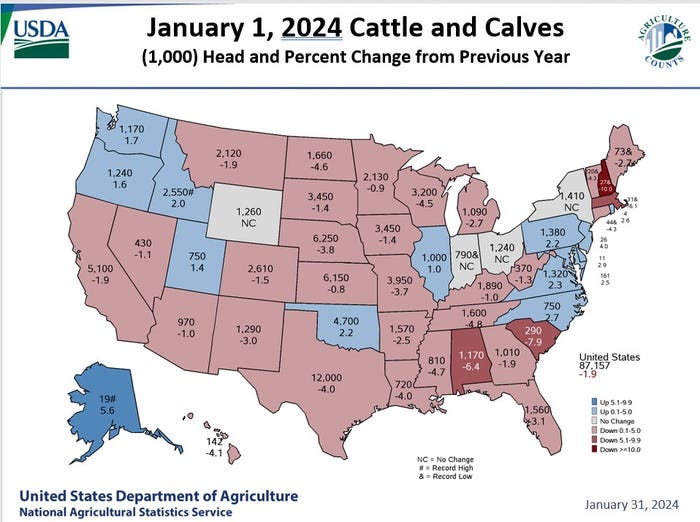USDA cattle inventory numbers show further decline
Posted on January 31, 2024 by Krissa Welshans
Source: Farm Progress. The original article is posted here.

Pre-report trade estimates suggested further declines were on tap for the U.S. cattle sector, a reality that was confirmed in USDA’s National Agricultural Statistics Service (NASS) numbers released today in the highly anticipated “Cattle” report. NASS numbers revealed all cattle and calves in the U.S. as of January 1, 2024, totaled 87.2 million head, 2% below the 88.8 million head on January 1, 2023. This is the smallest inventory since 1951.
Travis Averill, livestock branch chief at USDA NASS, relayed that 34 States showed year-over-year inventory declines.

Beef cows, at 28.2 million head, were down 2% from a year ago. Beef replacement heifers, at 4.86 million head, were down 1% from a year ago.
Milk cows, at 9.36 million head, were down slightly from the previous year. Milk replacement heifers, at 4.06 million head, were down slightly from the previous year.
All cows and heifers that have calved, at 37.6 million head, were 2% below the 38.3 million head on January 1, 2023. Bulls weighing 500 pounds and over totaled 2.02 million head, down slightly from January 1, 2023.
All heifers 500 pounds and over as of January 1, 2024, totaled 18.5 million head, 1% below the 18.8 million head on January 1, 2023. Steers weighing 500 pounds and over as of January 1, 2024 totaled 15.8 million head, down 2% from January 1, 2023.
Calves under 500 pounds as of January 1, 2024, totaled 13.3 million head, down 3% from January 1, 2023.
The combined total of calves under 500 pounds and other heifers and steers over 500 pounds (outside of feedlots), at 24.2 million head, was 4% below January 1, 2023.
Four items worth noting
Dennis Smith, with Archer Financials, said four items jumped out from the numbers.
First, an inventory of 87.2 million is the smallest cattle inventory number going back to 1951. Second, the calf crop, at 33.593 million, is the smallest calf crop on record. Third, calf inventory under 500 pounds, at 13.284 million (97%), was smaller than expected and fourth, beef replacement heifers, at 99% (4.858 million) was smaller than expected.
Overall, Smith said zero heifer retention and smaller calves than expected is bullish feeder futures. “If the report is bullish toward feeders, then it's also bullish toward deferred Live Cattle futures,” he added.




